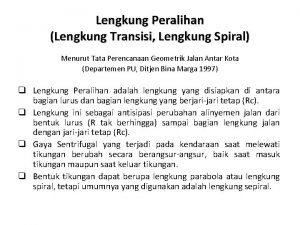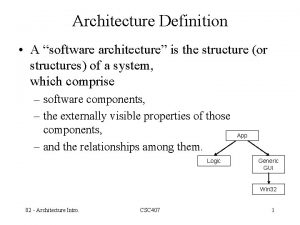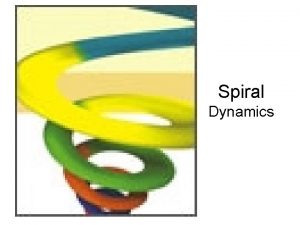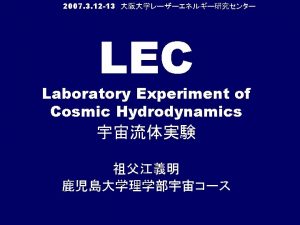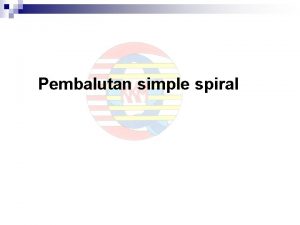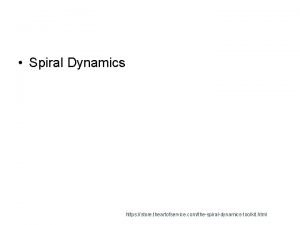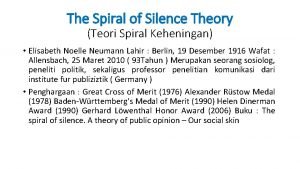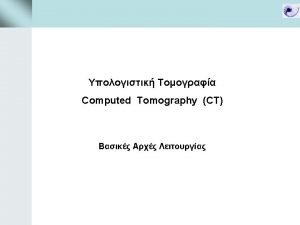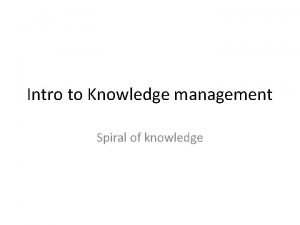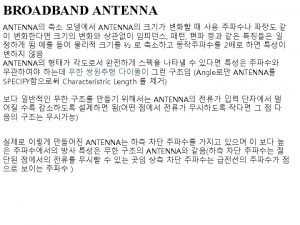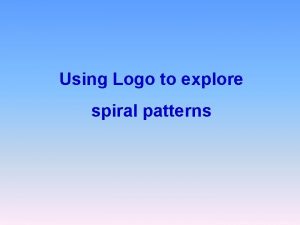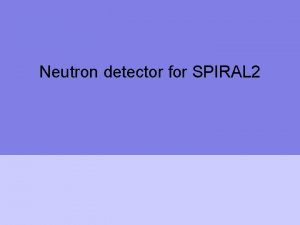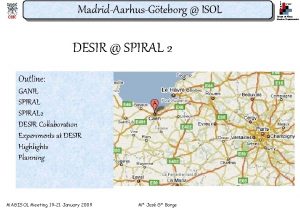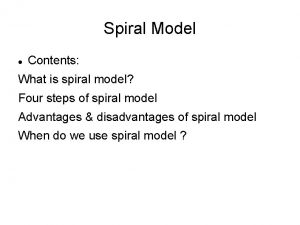SPIRAL TRAINING PRESENTATION OF THE SPIRAL METHODOLOGY from































- Slides: 31

SPIRAL TRAINING PRESENTATION OF THE SPIRAL METHODOLOGY from the Coordinating Group to the Gathering of Criteria of Well Being Salaspils (Latvia) | February 2, 2012

Presentation plan 1. A METHODOLOGY, WHY? 2. BEFORE STARTING 3. COORDINATING GROUP 4. HOMOGENEOUS GROUPS 5. GATHERING OF CRITERIA OF WB 6. CRITERIA ASSIGNMENT 7. SYNTHESIS OF CRITERIA OF WB 8. USING CRITERIA FOR ACTIONS 9. WELL BEING INDICATORS CONSTRUCTION 10. LOCAL ACTION PLAN 11. CO-EVALUATION OF EXISTING POLICIES This morning Practical Exercise This afternoon

A METHODOLOGY, WHY? To be part of a growing network in Europe: 12 countries, > 200 towns, > 100. 000 criteria of well-being collected from European citizens; To draw inspiration to set up or to improve your own local participatory process; To make the data comparable and shared with those of other communities; To follow different paths depending on the desired results, taking advantage of the modularity approach;

BEFORE STARTING SPECIFYING THE REFERENCE CONTEXT (town/city, village, neighbourhood, enterprise, school, hospital…); FINDING INSTITUTIONAL SUPPORT Local authorities (local govs); Local collective entities ( NGOs, enterprises, schools, hospitals, …); FINDING FINANCIAL SUPPORT Low budget provision, essentially operating costs: facilitators’ and moderators’ remuneration (unless coming from voluntary work) FINDING METHODOLOGICAL SUPPORT Council of Europe; Twinning with an existing experiment; Networking, in the framework of a larger project.

COORDINATING GROUP Group of people and organisations fully representing local society components, being legitimate to bring others along; Enjoy autonomy in the activities while involving all local actors (local govs and civil society); Being able (methods and tools) to put in practice and promote the co-responsibility in the local context; Formalisation (in a juridical form) is useful but not necessary; Thematic subgroups or commissions tackling local key problems (health, employment, education, etc…) are possible too;

KEY ACTORS First of all: THE PEOPLE NOT THE ORGANISATIONS Citizens : a large involvement is essential in order to get good results; Facilitators : at the forefront in the participatory process, always up-to-date about the local processes, providing expertise to the coordination group; Moderators: providing HG meeting facilitation and methodological support; Volunteers : It is essential to have people willing to help National facilitators (if applicable): in contact with other national CG and initiatives, exchanging best practices, linking different institutional levels; Data users and promoters : reporting and disseminating results

KEY POINTS Knowledge of existing local participatory dynamics; Sharing of values and objectives with participants; Sharing of a long term vision on the process among the members of CG; Voluntary-based collaboration and dynamic interplay of local actors; Ability to adapt the tool to the local situation without undermining the essential elements (participatory processes, co-responsibility, long term vision, …); A good communication and participatory strategy of initiatives (campaigns, viral communication, etc…) to draw media attention and get people motivated and involved ; Quality of results greatly depends on the quality of process;

HOMOGENEOUS GROUP Homogeneity : sharing a precisely defined set of characteristics (gender, age, job, service users, …) Involved on a basis of voluntary participation and /or selective invitation by active members of the coordination group. Focusing on qualitative data and interaction more than statistically representative sample. Enhancing legitimacy by giving a voice to citizens more rarely expressing in public (avoid “always the same people”) – strive to involve marginalised people, but also farmers, entrepreneurs…

HOMOGENEOUS GROUP 1 st HG MEETING – GATHERING OF CRITERIA Goal: defining well being for all, in the local area The methodology used is an adaptation from World Cafe methodology 1 moderator and 1 facilitator (member of CG) needed to conduct HG discussion Post-it blocks and flip charts must be provided, in order to let the people express and display their idea of WB / IB

1 st MEETING – GATHERING OF CRITERIA Facilitator introduces participants to the core concepts of methodology (well-being of all, co-responsibility, ongoing participatory process); Moderator (or facilitator) asks 3 open questions: 1. What does well-being mean to you? 2. What does ill-being mean to you? 3. What do you do or can you do to ensure your own well-being and the well being of all? 1 h each for individual response on the paper (one post -it = one criterion) and eventually discussion; Criteria are read one by one (keeping anonymity) and moderator asks if everybody clearly understand the meaning.

1 st MEETING – GATHERING OF CRITERIA If it is so, criterion is stuck on the flip chart according to theme; If the criterion is not clear, moderator opens up the discussion asking the participants, including the person who has expressed it, to reach an agreement on the understanding of criterion; The discussion can lead to amend it and clarify the meaning of the criterion (specifying it in brackets, on the same piece of paper); The meeting proceeds in this way until there are no more criteria to read; Conclusion announcing the 2 nd meeting (validation and synthesis) emphasizing the importance of a durable commitment and that citizens are involved as local actors, asked to go beyond well being definition, moving to action accordingly;

CRITERIA PROCESSING Once the meeting is over, criteria are entered in the ESPOIR software Each criterion is assigned to a family and to a component of WB Normally facilitator is in charge of doing it After having assigned criteria synthesis and statistics are automatically available by using ESPOIR software

CRITERIA PROCESSING WHAT IS A CRITERION OF WB / IB? The criterion is the unit of sense corresponding to an idea of well-being / ill-being expressed by one member of a homogenous group then discussed, possibly amended, clarified and thematized by the group during the first meeting. WHAT DOES ASSIGNMENT OF CRITERIA MEAN ? The assignment consists in reading, understanding and classifying each criterion into a dimension and into a component of well-being according to its explicit meaning. There are 10 rules aimed at facilitating assignment activity (we can also provide examples).

ASSIGNEMENT OBJECTIVE What does it aim for? Integrate the criteria of well being into a common reference system represented by the GRID OF DIMENSIONS AND COMPONENTS OF WELL-BEING; Ensure that data are comparable among the different contexts in which the methodology is applied; Ensure that data can be easy-to-use in the following steps (eg, . : statistical elaboration, other participatory processes…).

GRID OF DIMENSIONS AND COMPONENTS OF WB Where does it come from? The grid is the result of all other processes of well being criteria collecting. In fact, it exists in the form in which you see it, as citizens have expressed an idea of well being or ill being concerning one of the 8 families and of 60 components of human well being.

TIME BUDGET Merely indicative: Once a month, the coordination group meet up (2 -3 h) Unlimited number of HG (according to reference context) each one composed by 7 to 12 people 4 hours meeting per HG (2 meetings) 200 criteria of WB per group (aver. ) Criteria processing: about 200 criteria per working day (one person) Time for communication and meetings

OVERVIEW OF THE FIRST STEPS 1. CONSTITUTING COORDINATING GROUP; 2. FORMING HOMOGENEOUS GROUPS 3. 1 ST HG MEETING: GATHERING OF CRITERIA OF WB / IB; 4. CRITERIA PROCESSING through ESPOIR software (facilitators); 5. 2 nd HG MEETING : VALIDATION OF CRITERIA AND SYNTHESIS ;

III – 10 rules HOW DO WE DO IT? From the methodological point of view, it is necessary that criteria assignment is homogeneous and agreed with all stakeholders involved in the process. 5 RULES CONCERNING THE UNDERSTANDING OF CRITERIA 5 RULES CONCERNING ASSIGNMENT OF CRITERIA

III – 10 rules : the understanding GETTING INFORMATION ON PEOPLE EXPRESSING CRITERIA OF WELL-BEING: 1. All information concerning the person who expressed the criterion must be taken into account (homogeneous group affiliation, age, gender, etc…). This implies identifying information when registering the group in the “ESPOIR” system.

III – 10 rules : the understanding IDENTIFYING EXPLICIT MEANING: 2. We must focus on the explicit meaning of the criterion: what is written in the criterion and can be understood without any reference to external elements: cultural references, common sense, clichés producing over-interpretation;

III – 10 rules : the understanding The 3 elements of criterion: 3. The "purpose" of the criterion, which is the element (or set of elements) directly related to the more explicit sense of well-being / ill-being contained in the criterion (e. g. a result, target object, dimension affected).

III – 10 rules : the understanding The 3 elements of criterion: 4. The "topic" of the criterion (work, health, environment, etc. ). Which is often confused with the purpose. They may coincide, but this is not always the case.

III – 10 rules : the understanding The 3 elements of criterion: 5. The "actors" who perform the action and who or what is the object of this action (speaker of the criterion, the others, institutions, society in general).

III – 10 rules : the understanding RELATIONSHIP BETWEEN THE ELEMENTS 6. We need to identify in each criterion the items discussed above, consider the differences and relations between them and try to compare several similar criteria in order to a coherent argument that explains the assignment.

III – 10 rules : the understanding THE QUESTION RELATED 7. Mind that the question to which the criterion answers is important to understand the relationship between the actors and the purpose (especially for the third question).

III – 10 rules : the understanding THE GRID AND THE PRACTICE 8. In order to get help with the assignment of criteria we can also refer to the description of the contents of the dimensions and components of well-being provided in the grid

III – 10 rules : the understanding CHALLENGING CRITERIA 9. When in doubt on the explicit meaning of criteria and on the essential elements, assignment must follow the rule of “general meaning, general assignment”.

III – 10 rules : the understanding CHALLENGING CRITERIA 10. If the criterion is unclear or contradictory, i. e. it is not possible to be certain of a unique and explicit interpretation, it is better not to take it into consideration, in order to avoid arbitrary interpretation, and thus suspend the assignment by placing it in the dimension N. In any case, it is always possible to clarify the meaning and retrieve it afterwards with the citizens during the 2 nd meetings.

IV – FREE assignment COMPLEMENTARY assignment The “double assignment” making possible to show the relationship between the different dimensions of well-being. Helpful to identify (especially for composite criteria) items that are also important as a "condition" for the realization of well-being / ill-being. The “free assignment” (tagging) that is made by adding keywords to the criteria as a bookmark for later analysis by free subject.

2 nd MEETING – VALIDATION OF CRITERIA Facilitators introduce the participants (HG) to the criteria assignment methodology (rules of understanding and classification); Facilitators illustrate distribution of criteria throughout the 60 components of WB; Facilitators provide A 1 size sheet with synthesis of criteria distribution by indicators and by groups; Each HG work on his own criteria; Criteria can be furtherly discussed and assignment amended by the HG; In case of dispute, the facilitator can either lead the discussion to a more general consensus, or invite participants to add complementary criteria.

2 nd MEETING – VALIDATION OF CRITERIA Eventually, a 4 th questions can be asked to HG concerning well-being of future generations: Having defined their own idea of well-being in the local area: 4. Should other criteria be added in order so that this well being good also be accessible for future generations? Emphasizing sustainability of criteria of well-being, and enabling local processes to re-think objectives and policies including future generations
 Lengkung scs
Lengkung scs Conceptual integrity in software architecture
Conceptual integrity in software architecture Hát kết hợp bộ gõ cơ thể
Hát kết hợp bộ gõ cơ thể Lp html
Lp html Bổ thể
Bổ thể Tỉ lệ cơ thể trẻ em
Tỉ lệ cơ thể trẻ em Chó sói
Chó sói Thang điểm glasgow
Thang điểm glasgow Hát lên người ơi alleluia
Hát lên người ơi alleluia Các môn thể thao bắt đầu bằng từ đua
Các môn thể thao bắt đầu bằng từ đua Thế nào là hệ số cao nhất
Thế nào là hệ số cao nhất Các châu lục và đại dương trên thế giới
Các châu lục và đại dương trên thế giới Công thức tiính động năng
Công thức tiính động năng Trời xanh đây là của chúng ta thể thơ
Trời xanh đây là của chúng ta thể thơ Mật thư tọa độ 5x5
Mật thư tọa độ 5x5 Phép trừ bù
Phép trừ bù độ dài liên kết
độ dài liên kết Các châu lục và đại dương trên thế giới
Các châu lục và đại dương trên thế giới Thơ thất ngôn tứ tuyệt đường luật
Thơ thất ngôn tứ tuyệt đường luật Quá trình desamine hóa có thể tạo ra
Quá trình desamine hóa có thể tạo ra Một số thể thơ truyền thống
Một số thể thơ truyền thống Cái miệng xinh xinh thế chỉ nói điều hay thôi
Cái miệng xinh xinh thế chỉ nói điều hay thôi Vẽ hình chiếu vuông góc của vật thể sau
Vẽ hình chiếu vuông góc của vật thể sau Thế nào là sự mỏi cơ
Thế nào là sự mỏi cơ đặc điểm cơ thể của người tối cổ
đặc điểm cơ thể của người tối cổ Giọng cùng tên là
Giọng cùng tên là Vẽ hình chiếu đứng bằng cạnh của vật thể
Vẽ hình chiếu đứng bằng cạnh của vật thể Fecboak
Fecboak Thẻ vin
Thẻ vin đại từ thay thế
đại từ thay thế điện thế nghỉ
điện thế nghỉ Tư thế ngồi viết
Tư thế ngồi viết
